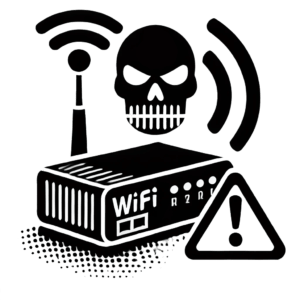Defining WiFi Penetration Testing

WiFi penetration testing, also known as WiFi pen testing, is a crucial cybersecurity practice aimed at identifying vulnerabilities in a wireless network’s security infrastructure. With the increasing prevalence of rogue access points and the potential security risks they pose, conducting WiFi penetration testing is essential for protecting your network against unauthorized access and data breaches.
In WiFi penetration testing, cybersecurity experts pretend to be hackers to find weak spots in the wireless network that could be used by bad guys. By testing the security settings, encryption methods, and access controls, they can help organizations improve their defenses and fix any potential problems before they become a real threat.
By incorporating WiFi penetration testing into your cybersecurity strategy, you can prevent unauthorized access to your network, safeguard sensitive data, and enhance overall security posture. With the continuously evolving threat landscape, regular WiFi penetration testing is crucial for ensuring the integrity and resilience of your network infrastructure.
Why Rogue Access Points are a Threat
Unauthorized wireless access points, known as rogue access points, are a big problem for network security. They can be set up by malicious people without the knowledge of the network admins. They can be used to steal sensitive data, carry out sneaky attacks, and get into the network without permission.
One major risk is that they can create a secret entryway into the network, sneaking past the normal security protections and making the network open to attacks. This could result in hackers stealing data, getting into private information, and messing with important systems.
WiFi pentesting is crucial in identifying and mitigating the risks posed by rogue access points. By conducting regular security assessments and scans, organizations can detect and eliminate threats before they are exploited by cybercriminals. Implementing strong authentication protocols, encryption methods, and intrusion detection systems are essential in protecting the network from the threats posed by rogue access points.
Understanding Rogue Access Points
In the realm of cybersecurity, rogue access points pose a significant threat to network security. These unauthorized wireless access points are often set up maliciously by cyber attackers to intercept sensitive data and launch various cyber attacks. The setup process involves exploiting vulnerabilities in network security protocols and deploying deceptive tactics to fly under the radar.
Attackers often use a sneaky trick to set up fake Wi-Fi networks that look harmless. They do this by using small devices that look like regular hotspots. These fake networks are placed near a real network to trick people into connecting to them. Then, the hackers can listen in on private conversations, steal passwords, and even infect devices with harmful software.
To fortify your network against rogue access points, conducting regular WiFi penetration testing is crucial. By simulating real-world attack scenarios, penetration testers can identify vulnerabilities in network defenses and proactively implement security measures to prevent threats from infiltrating the network.
Impacts of Rogue Access Points on Network Security

Rogue access points can pose serious threats to network security by providing unauthorized access to sensitive data, facilitating man-in-the-middle attacks, and creating potential entry points for malicious actors. These rogue devices often mimic legitimate WiFi networks, leading unsuspecting users to connect to them and unknowingly expose their data to cybercriminals. By intercepting network traffic, they can steal confidential information, such as login credentials and financial details, putting both individuals and organizations at risk.
Furthermore, rogue access points bypass traditional security measures, making it challenging for network administrators to detect and mitigate these threats effectively. They can act as a backdoor into the network, allowing attackers to conduct reconnaissance, launch further attacks, or infiltrate the organization’s systems undetected. The presence of rogue access points can also degrade network performance and reliability, leading to disruptions in operations and potential financial losses.
To safeguard against the impacts, organizations must conduct regular WiFi penetration testing to identify and eliminate vulnerabilities. By proactively testing for rogue access points and implementing robust security measures, businesses can strengthen their network defenses and protect sensitive information from unauthorized access.
Prevention Strategies
Implementing Network Access Control
Protecting your network from potential threats is important. One way to do this is by using network access control (NAC). NAC is a security tool that helps organizations stay safe by managing who can access their network and when. By setting rules about which devices and users are allowed on the network, NAC helps stop unauthorized access and lowers the chances of security problems.
During a WiFi penetration testing for rogue access points, it is essential to ensure that your network access control measures are in place and working effectively. Rogue access points are unauthorized devices that can be used by attackers to gain access to your network and steal sensitive information. With NAC in place, you can detect and block any unauthorized devices attempting to connect to your network, thwarting potential attacks before they happen.
By implementing network access control as part of your overall network security strategy, you can strengthen your defenses against rogue access points and other security threats, ensuring that your network remains secure and protected.
Securing Wifi Communication
In the world of online security, WiFi networks are often at risk of being infiltrated by malicious actors through rogue access points. To protect your data, it’s important to regularly test your WiFi network for vulnerabilities and take steps to make it more secure. This includes using strong encryption and password protection. By staying vigilant and monitoring your network for any unauthorized access points, you can help prevent cyber attacks and keep your information safe.
Moreover, it’s crucial to teach employees how important it is to only use secure WiFi connections and to avoid unfamiliar networks. This can minimize the chances of being targeted by malicious cyber attacks. By taking these precautions and investing in robust security measures, you can better protect your network from any potential threats and keep your information safe and secure.
Wifi Penetration Testing Tools
When it comes to protecting your network from security threats, it’s important to stay ahead of hackers. WiFi penetration testing is a useful way to find weaknesses in your network, like unauthorized access points that could be dangerous. By using the right tools, you can check your network’s security and fix any problems before they’re exploited.
With the evolution of technology, there are a variety of advanced WiFi penetration testing tools available that cater to different aspects of network security assessment. These tools enable cybersecurity professionals to simulate attacks, identify weaknesses, and enhance the overall security of their networks. From wireless packet sniffers to password cracking tools, WiFi penetration testing tools offer a comprehensive approach to identifying and addressing security gaps.
By incorporating WiFi penetration testing tools into your cybersecurity strategy, you can effectively protect your network from rogue access points and other potential threats. Stay proactive in safeguarding your network and utilize the power of WiFi penetration testing tools to fortify your defenses against cyber threats.
Detecting and Dealing with Rogue Access Points
As businesses and individuals rely heavily on WiFi networks for connectivity, the threat of rogue access points poses a significant risk to network security. They are unauthorized wireless access points that are deployed within a network without proper authorization, opening up vulnerabilities for potential breaches and attacks.
When conducting WiFi penetration testing to protect your network from rogue access points, it is crucial to implement robust detection mechanisms. Tools like WiFi analyzers and intrusion detection systems can help in identifying any unauthorized access points within your network. Regular security audits and monitoring can also aid in ensuring that only authorized access points are operational.
In dealing with rogue access points, prompt action is necessary to mitigate potential risks. This may involve disabling or disconnecting unauthorized access points, updating security protocols, and reinforcing network encryption. Additionally, educating employees and users about the risks associated with rogue access points and the importance of network security can help in preventing future incidents.
By actively detecting and dealing with threats in your network, you can strengthen your cybersecurity defenses and safeguard sensitive information from malicious attacks.
Rehash of Key Points
Safeguarding your internet connection is important. WiFi ‘check-ups’– known as penetration testing– are key to finding and fixing any problems that may show up due to unwanted connections. These out-of-place devices can let harmful hackers sneak into your system, possibly accessing your private data and causing security problems. By regularly performing these ‘check ups’, you can spot weak spots in your WiFi system early and take the right steps to make it more secure.
One of the key points emphasized in WiFi penetration testing is the need for strong authentication mechanisms, such as WPA3 encryption, to prevent unauthorized access to your network. Additionally, implementing intrusion detection systems can help in monitoring network traffic and detecting any suspicious activities associated with rogue access points.
It’s important to teach employees about the dangers of using unknown or unsecured WiFi networks. This can help improve network security by promoting good cybersecurity habits and making people more aware of potential threats. By doing this, you can lower the chances of falling prey to attacks that come through fake WiFi spots.
Importance of Regular Network Audits
Regularly checking your network is important to keep it safe and running smoothly. By doing routine audits, organizations can find any weak points and risks in their network, and then take steps to secure it. It’s especially important now with more unauthorized access points popping up in WiFi networks. Making sure to regularly audit your network can help you spot and remove any of these unauthorized access points.
By conducting network audits, you can proactively identify and address vulnerabilities in your network, including misconfigured devices, outdated software, and unauthorized access points. This enables you to strengthen your network defenses and prevent unauthorized access to sensitive data. Additionally, regular audits help organizations comply with industry regulations and standards by ensuring that security measures are up to date and effective.
In simple terms, conducting regular network audits is important for keeping your network safe from hackers and unauthorized users. This helps to protect your sensitive information and keep your network running smoothly.
